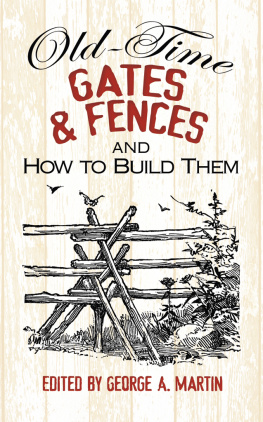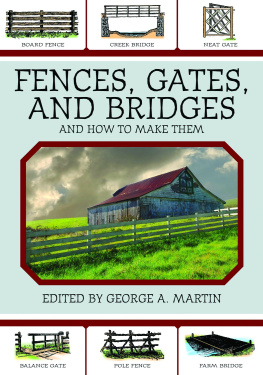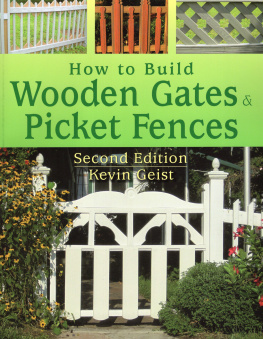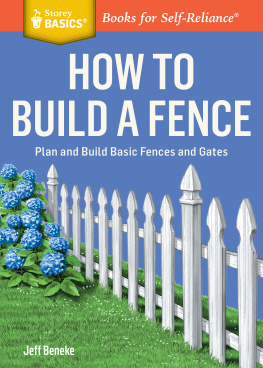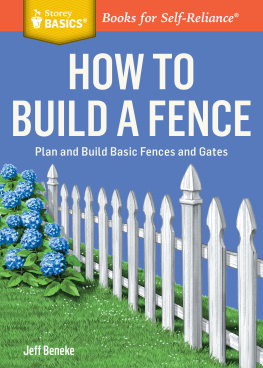
old - Time
GATES & FENCES
AND
HOW TO BUILD THEM
EDITED BY
GEORGE A. MARTIN
DOVER PUBLICATIONS, INC.
MINEOLA, NEWYORK
Bibliographical Note
This Dover edition, first published in 2013, is an unabridged republication of the 1900 printing of the work originally published by O. Judd and Company, New York, in 1887 under the title Fences, Gates and Bridges: A Practical Manual.
Library of Congress Cataloging-in-Publication Data
Fences, gates, and bridges
Old-time gates and fences and how to build them / [edited by] George A. Martin.
p. cm.
Reprint of the 1900 publication originally published by O. Judd and Company, New York in 1887 under the title: Fences, gates, and Bridges : a practical manual.
Summary: First published over a century ago, this practical guide shows how to add traditional fences, gates, and bridges to your house, farm, or garden. More than 300 illustrations accompany straightforward instructions for installing stone, sod, board, picket, and other types of fences as well as hedges, stiles, posts, wooden and iron gates, and similar enclosures Provided by publisher.
eISBN-13: 978-0-486-78245-4
1. FencesDesign and construction. 2. GatesDesign and construction. 3. BridgesDesign and construction. I. Martin, George A., 1904. II. Title.
TH4965.F46 2013
631.27dc23
2013019269
Manufactured in the United States by Courier Corporation
49284201 2013
www.doverpublications.com
PREFATORY.

It is authoritatively stated that the building and maintenance of the farm fences in the United States have cost more than the construction of the farm buildings. Be this as it may, while large numbers of works have been written upon rural architecture we believe this is the first publication specially devoted to Fences, Gates and Bridges. It aims to be a practical work, showing the evolution of the fence from the road barrier of logs, brush or sods to the latest improved forms of barbed wire. The numerous illustrations are mainly representations of fences, gates, etc., in actual use. The chapter on fence law is necessarily condensed. The various judicial decisions upon the subject alone would fill a large volume.
This little work, the first and only one of its character, is given to the public in the confident hope that it will prove specially useful to farmers and village residents.
TABLE OP CONTENTS.

.
.
.
.
.
.
.
.
.
.
.
.
.
.
.
.
.
.
.
.
.
.
.
.
.
.
.
.
C H A P T E R I.
RAIL AND OTHER PRIMITIVE WOOD FENCES.
VIRGINIA RAIL FENCE.
depends very largely on the manner of placing the props, both as to the distance of the foot of the prop rail from the fence panel, and the way it is locked at the corner.

Fig. 1.VIRGINIA ZIGZAG FENCE COMPLETE.

LAYING A RAIL FENCE.
It is much better, both for good looks and economy, to have the corners of a rail fence on each side in line with each other. This may be accomplished by means of a very simple implement, shown in resting on the support. In the same way the next corner and all others are laid, the gauge being moved from corner to corner, set in the line of fence, and the arm swung alternately to the right and left.
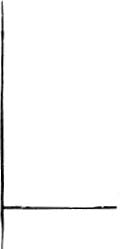
Fig. 2.

Fig. 3.THE FENCE BEGUN.

STAKING AND WIRING.
A neater and more substantial method of securing the corners of a worm fence is by vertical stakes and wires, as shown in the accompanying illustrations. When the lower three rails are laid, the stakes are driven in the angles close to the rails and secured by a band of annealed wire. The work of laying the rails proceeds, and when within one rail of the top, a second wire band is put in place. Or the upper wire may be put on above the top rail. Annealed wire is plentiful and cheap.

Fig. 4.STAKES IN LOCK.
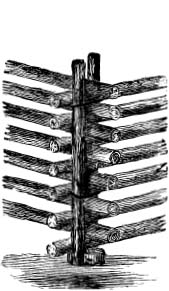
Fig. 5.STAKES IN ANGLES.
A FENCE OF STAKES AND RIDERS.
A very common method with the worm or Virginia rail fence is to drive slanting stakes over the corner in saw-horse style, and lay the top rail into the angle thus formed. The stakes, resting on the rails and standing at angle, brace the fence firmly. But the feet of the stakes extending beyond the jagged corners formed by the ends of the rail are objectionable. This is remedied in part by putting the stakes over the middle of the panelat considerable distance apartand laying in them long poles horizontally. In this case the stakes should be set at such an angle as to prevent their moving sidewise along the top rail, which should be a strong one. These stakes and long riders are frequently used to raise the hight of low stone walls. stakes, split or round poles, are driven over these and the next poles laid in. Then two more stakes and another pole, and so on as high as the fence is required. This will answer for larger animals, and be strong and not expensive. For swine, and other small live-stock, the crotch stakes may be replaced by blocks or stones, and the lower poles be small and begin close to the ground.

Fig. 6.A STAKE AND RIDER FENCE.

Fig. 7.A POLE FENCE.

A POLE FENCE.
A fence which is cheaply constructed in a timbered region, and calls for no outlay whatever, besides labor, is illustrated at receive the pins. When they are set, the pins are driven diagonally into the posts, and the poles laid in place. It would add much to its strength, if the poles were laid so as to break joints. A modification of this fence is sometimes made by using withes instead of pins to hold the poles in place. The withe is made of a young sapling or slender limb of beech, iron-wood, or similar tough fibrous wood, with the twigs left on. This is twisted upon itself, a strong loop made at the top, through which the butt is slipped. When in place, the butt end is tucked under the body of the withe.
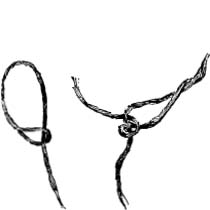
Next page
